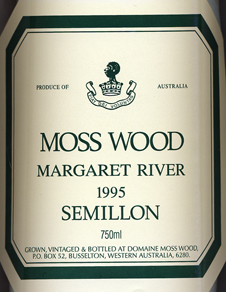Moss Wood 1995 Semillon

Wine Facts
| Harvested: | 22/2/1995 |
| Bottled: | 27/7/1995 |
| Released: | 26/10/1995 |
| Baume: | 13.20 |
| Alcohol: | 13.50% |
| Vintage Rating: | 8/10 |
SOLD OUT
Tasting Notes
The 1995 Moss Wood Semillon has aromas of figs, apples and hints of grassiness and passionfruit while its palate shows similar flavours complexed by yeasty, bready, almost earthy characters and hints of butterscotch. It is a big wine with a generous palate structure, good balance and fresh, crisp acidity. Its depth of fruit and lovely mouthfilling qualities make it similar to the previous vintage but with more class, greater freshness and livelier acidity. It is more rounded and sophisticated than the outstanding 1985 and we believe that it is more attractive now and will age better than any young semillon we have made.
Vintage Notes
The 1995 vintage was about two weeks earlier than usual with warm weather at the end of February sending the ripeness through the roof. Although the grapes were picked as quickly as possible, the alcoholic levels were higher than expected. The wine has showed good ripeness with generous yet restrained fruit, perhaps closer in style to the delicacy of 1993 than to the blockbuster qualities of 1994. In fact, we believe that it is quite like the 1985 but without the contribution made by the searing heat of that vintage.
The season was very dry and so there were no problems with disease. There were, however, problems with birds for the first time in several years. Following the impressive results achieved in averting a serious bird problem by netting Ian "Tinker" Bell's own Yallingup vineyard, we are considering some state-of-the-art netting at Moss Wood.
Production Notes
The crop level for semillon was down by about 1 tonne or about 5% on the previous vintage but the gentle extraction of the new press meant, that in spite of this hiccup Moss Wood production was slightly higher than usual. The other advantage of the new press was that solid contents in the semillon was reduced and losses at settling were cut in half. All this was achieved along with an improvement in juice quality. The wine spent some time, post-fermentation, on its lees in tank and part of it underwent a malolactic fermentation: all of which has given it greater complexity.
Cellaring Notes
Will cellar well for five to six years but save a little because it should be great at ten years of age.
